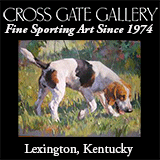 It’s a shame that there exists a disconnect between AKC foxhound standards and those of the foxhunting community. Not that foxhunters need be concerned with AKC foxhound standards. The Masters of Foxhounds Associations in this country and in England maintain their own breed registries, and both registries are orders of magnitude larger than the AKC foxhound registry.
It’s a shame that there exists a disconnect between AKC foxhound standards and those of the foxhunting community. Not that foxhunters need be concerned with AKC foxhound standards. The Masters of Foxhounds Associations in this country and in England maintain their own breed registries, and both registries are orders of magnitude larger than the AKC foxhound registry.
One would think, though, that the AKC should be more than a little interested in what foxhunters are breeding. After all, foxhunters are the ones using foxhounds for the purpose for which they were originally bred.
To look at the AKC standard for the English foxhound is to be stuck in a time warp of more than fifty years. According to a recent article by Ann Roth in DogChannel.com, the AKC breed standard for the English Foxhound was composed more than fifty years ago by foxhunters.
I’m not certain just which foxhunters the AKC was talking to fifty years ago, but I don’t believe the English foxhound photo accompanying Roth’s article or the English foxhound painting found on the AKC website would have been models for any pack of that time, here or in England. They are more reminiscent of the so-called Shorthorn era in England, a period between the mid-nineteenth and the early twentieth centuries, when fashionable foxhounds of the time were criticized for resembling Shorthorn cattle.
In her definitive book, Foxhounds, Daphne Moore wrote, “Throughout the 1920s and most of the 1930s the massive, heavily-built foxhound was still prevailing,” yet the breeding revolution started by American Ikey Bell was “steadily gaining ground.”
Surely by mid-century, Bell had convinced most English hound breeders to abandon their ponderous foxhound for what we now refer to as the modern English foxhound. It should be said at this point that there are still respected breeders of the “old English” or “traditionally-bred English foxhounds” in England, but today those hounds are considerably lighter in bone, more relaxed in the front legs, and more athletic in their movement than their predecessors.
The division between our two camps surely doesn’t benefit the foxhound. Wouldn’t it be good for foxhounds and the AKC if the AKC standard were more aligned with the type of foxhound that has been hunting the fox both here and in England for the last seventy-five years? Perhaps it’s time for dialog between the two enthusiasts’ camps. Wouldn’t it make sense for some top AKC hound judges to visit MFHA-sanctioned hound shows (and in particular, the Virginia Foxhound Show with its large English entry) to see what foxhunters are breeding? Why do we continue to ignore each other?
Posted August 2, 2013


















